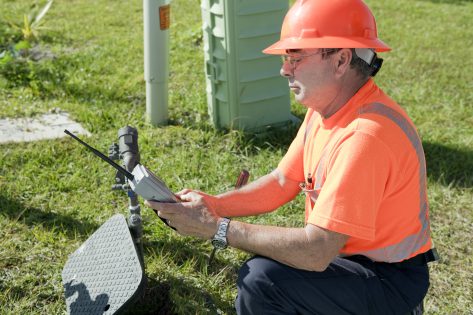Utilities, like the technology they rely upon, must continually evolve. Innovations that are ushered in with great fanfare are soon being replaced with new and better technology to increase efficiencies, lessen the impact on the environment, and save time and money.
Such is the case with Suffolk County Water Authority (SCWA). As the largest groundwater supplier in the US and having just recently celebrated its 70-year anniversary, SCWA is undoubtedly no stranger to innovation. Over the years, the Authority has led with the introduction of automated chlorinating equipment, an atomic absorption spectrophotometer for in-house water analysis, and was the first utility to use an Advanced Oxidation Process (AOP) system for groundwater.
In a recent case study webinar, experts from SCWA and IFS examined advances in water services technology and how the Authority implemented automated meter reading (AMR) with an advanced metering infrastructure (AMI) while supporting a mixed meter environment.
Water meter technology over the years
The original meter did little more than measure usage. To collect this information, human meter readers had to attend to each meter physically. These workers would walk through neighborhoods, reading dials and inputting by hand the data they collected.
Automated meter reading (AMR) arrived in the 1970s, allowing utilities to automatically collect consumption, diagnostic, and status data. This information is sent via a one-way communication to the utility.
In the early 2000s, Advanced Metering Infrastructure (AMI) arrived, driving further enhancements for the AMR model. AMI provides digital versions of the traditional meter, along with a two-way communication model. The technology measures consumption and, when consumption occurs, transmitting pricing and usage information from the utility to the consumer.
The SCWA journey
SCWA decided to convert to an AMR/AMI strategy to resolve some long-standing issues:
- Aging meters
- Cost of meter reads/inaccurate reads
- Inconsistent infrastructure and customer data following the acquisition of smaller water districts over the years
The legacy system was cumbersome and inefficient, impacting the customer experience while driving up costs. By implementing AMR, the Authority would almost eliminate all manual meter reads.
SCWA began its AMR journey with a pilot project in August of 2008. As an independent public-benefit corporation, the Authority operates without taxing power on a not-for-profit basis. This required a reasonable and systematic strategy to convert over 390,000 meters, stretching the project over ten years to help manage costs.
Initially, the Authority had intended to rely on third-party contractors for the meter replacement work. But it quickly realized that it could increase efficiencies by having SCWA workers replace meters whenever they were making calls in the field. This allowed SCWA to carry out 25% of the meter replacements using its own resources, with the contractor managing the other 75%.
SCWA has about a 50/50 split between residential and business/industrial meters, with a similar break between indoor and outdoor. This presented some challenges when collecting meter information. The Authority selected Itron as its AMI, enabling a drive-by system to read the meters regardless of placement.

Mobile Workforce Management for mixed meter environments
Even once AMI infrastructure is deployed and most meters replaced, a utility must still manage a mixed environment due to other factors such as customer opt-outs. With the rare exception of Sweden, where 100% of the population uses smart meters, mixed-meter environments are the standard.
Given SCWA’s 10-year deployment strategy due to its funding model, the Authority had a much broader mixed landscape to support. Toward the end of the rollout, SCWA decided to implement the Mobile Workforce Management platform from Clevest, an IFS company.
Along with seamless integration with the Authority’s SAP infrastructure and an entirely paperless work order system, Mobile Workforce Management automates work orders with data moving bi-directionally via mobile devices used by workers in the field.
Although the AMR system worked for drive-by reads, the meter reading process was not automated when a field technician was onsite at someone’s home. Instead, the worker would have to transcribe the information and manually share it with the back office after the call. Working with the Clevest team, SCWA devised an API that talked to the Bluetooth Itron system, transmitting the meter information to the worker’s mobile device and eliminating the need for manual, handwritten recordkeeping.
The MWM platform delivered significant efficiencies for the Authority. With automated scheduling capabilities, SCWA knew where and when meters had been replaced. If a field technician made a house call to a residence with a legacy meter, the dispatcher could adjust the work order to include a meter replacement. With real-time oversight and accurate information, jobs could be carried out more efficiently with fewer truck rolls to accommodate the work.
Today, all SCWA field technicians use a uniform mobile device, making it easy to train new hires. With a union division, the Authority can also support the ebb and flow of different people attending to the work. Each mobile device has the necessary software—no need for multiple apps to obtain a read from any meter.
The results
Ultimately, the AMR project came in at almost $5M under budget and ahead of schedule. Close to 390,000 meters were transitioned to AMR technology, providing SCWA with a far more efficient and data-driven process of collecting water use information.
Almost immediately, SCWA could use data to pinpoint the usage patterns of its largest water consumers, such as organizations running irrigation. With AMR, the Authority can proactively help these customers detect leaks, with built-in leak indicators for early alerting to avoid excessive charges. The system is also enabled with tamper codes to detect any efforts to bypass the system and reverse flow indicators for more accurate measurement.
With better consumption and better billing, it’s a win-win for the Authority. SCWA continues to explore new innovations to improve how it engages with its customers while driving efficiencies across the operation.
For the full story, watch the on-demand webinar or read the customer case study.
Do you have questions or comments?
We’d love to hear them so please leave us a message below.